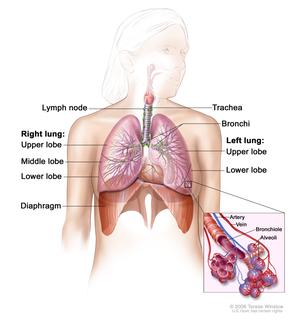Asthma
What Is Asthma?
Asthma is a chronic disease of the lungs. It affects over seven million children in the United States (about 10% of children under age 17). Asthma causes episodes of coughing, wheezing, and shortness of breath. If not controlled, these episodes can lead to visits to the doctor, trips to an emergency room, and in some cases, overnight hospital stays.

Asthma (AZ-ma) is a chronic (long-term) lung disease that inflames and narrows the airways. Asthma causes recurring periods of wheezing (a whistling sound when you breathe), chest tightness, shortness of breath, and coughing. The coughing often occurs at night or early in the morning.
Asthma affects people of all ages, but it most often starts during childhood. In the United States, more than 25 million people are known to have asthma. About 7 million of these people are children.
Overview
To understand asthma, it helps to know how the airways work. The airways are tubes that carry air into and out of your lungs. People who have asthma have inflamed airways. The inflammation makes the airways swollen and very sensitive. The airways tend to react strongly to certain inhaled substances.
When the airways react, the muscles around them tighten. This narrows the airways, causing less air to flow into the lungs. The swelling also can worsen, making the airways even narrower. Cells in the airways might make more mucus than usual. Mucus is a sticky, thick liquid that can further narrow the airways.
This chain reaction can result in asthma symptoms. Symptoms can happen each time the airways are inflamed.
Asthma

Sometimes asthma symptoms are mild and go away on their own or after minimal treatment with asthma medicine. Other times, symptoms continue to get worse.
When symptoms get more intense and/or more symptoms occur, you’re having an asthma attack. Asthma attacks also are called flareups or exacerbations (eg-zas-er-BA-shuns).
Treating symptoms when you first notice them is important. This will help prevent the symptoms from worsening and causing a severe asthma attack. Severe asthma attacks may require emergency care, and they can be fatal.
Outlook
Asthma has no cure. Even when you feel fine, you still have the disease and it can flare up at any time.
However, with today’s knowledge and treatments, most people who have asthma are able to manage the disease. They have few, if any, symptoms. They can live normal, active lives and sleep through the night without interruption from asthma.
If you have asthma, you can take an active role in managing the disease. For successful, thorough, and ongoing treatment, build strong partnerships with your doctor and other health care providers.
How Can I tell if my child has asthma?
There are several “key indicators” that are often present in asthma. They are:
- A history of recurrent wheezing that responds to inhalation/breathing treatment
- Chronic cough, usually worse at night and/or with activity
- Wheezing that has been observed by a health care provider that improves with the use of an asthma rescue medication (albuterol, or similar medication, in a puffer or with an aerosol treatment)
- Repeated episodes of shortness of breath, or chest tightness, that may occur with colds, exposure to allergens, or activity
Call Hebron Pediatrics, Carrollton at (972) 695-9630 to schedule an appointment if you feel that your child has any of the above key indicators of asthma.
Asthma Action Plans
Every asthma patient should have an Asthma Action Plan, and you should go over this plan with your child’s physician. Click on one of the links below to print out an asthma action plan, and bring it with you to your next visit to our office.
Educational Videos
Asthma: ask us about learning more:
Using a metered dose inhaler with a spacer (English) : https://youtu.be/BbONuRXJdr0
Using a metered dose inhaler with a spacer (Spanish) : https://youtu.be/NdFstn28hWM